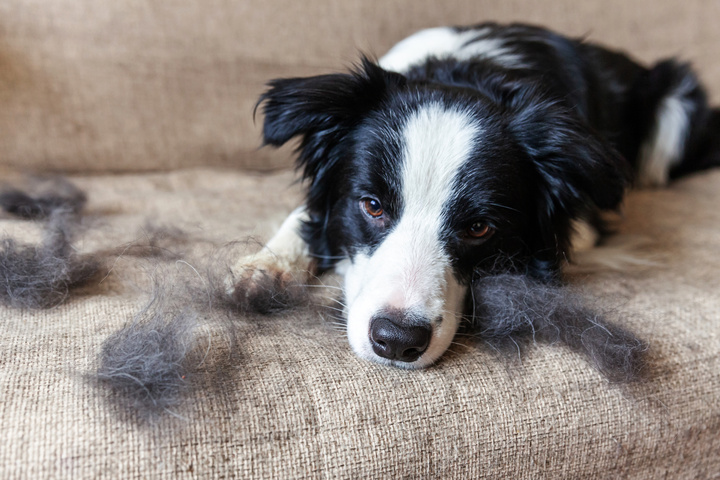Do you love dogs but hate the shedding? You are not alone. Most paw parents struggle to some degree with shedding – some more than others. While shedding is a natural process for canines – it doesn’t make it any less frustrating for owners. The amount that your furry friend sheds depends on several things, including breed, time of year, diet, and overall health.
Many dogs, especially those with double coats or thick fur, such as Huskies, Golden Retrievers, and German Shepherds, shed heavily during seasonal changes. They typically shed their winter coat in spring to prepare for warmer weather and shed their summer coat in fall to grow a thicker coat for winter. This shedding helps regulate their body temperature, rids the coat of damaged hair, and allows for new growth.
While you can’t stop your pup from shedding altogether, there are some things you can do to minimize the mess and keep your pup’s coat healthy.
Choose breeds that shed less
There is no such thing as a hypoallergenic dog, but some shed very little and produce less dander than others. These breeds make great pets for those with pet dander and fur allergies. They are also great for those who love dogs but want to forgo the shed!
Breeds known for minimal shedding include:
- Poodle. This popular breed has hair instead of fur, which means they shed very little.
- Bichon Frise. This breed has a curly coat that sheds minimally. Regular grooming is necessary to prevent matting.
- Maltese. Regular grooming keeps a long, silky coat from shedding too much.
- Shih Tzu. This popular small dog is known for its long, flowing coat that sheds minimally. Grooming is essential to prevent tangles and mats.
- Havanese. A soft, silky coat that doesn’t shed much.
- Portuguese Water Dog. This breed has a curly coat that sheds minimally.
- Italian Greyhound. This breed has a very short coat that sheds little.
- Basenji. Hailing from Africa, this cute canine has a short, fine coat that sheds minimally.
- Chinese Crested. The Chinese Crested comes in two varieties: the Hairless and the Powderpuff. The Hairless variety is mostly hairless except for some hair on the head, feet, and tail, while the Powderpuff has a soft, silky coat that sheds very little.
- Yorkshire Terrier. A long, silky coat that sheds minimally. Regular grooming is necessary to maintain their coat and prevent mats.
Adopt healthy habits to control shedding
If you have a very furry friend who sheds a lot, here are some things you can try to minimize the mess and keep your pup’s coat shiny and healthy.
Healthy diet. One of the best things you can do for your canine companion is provide a balanced and nutritious diet. A fresh or raw diet will improve your dog’s overall coat health and reduce shedding. Look for foods that contain high-quality protein sources, omega-3 fatty acids, and essential vitamins and minerals, and stay clear of kibble. Add supplements like fish, flaxseed, or omega-3 fatty acids to promote healthy skin and coat.
Groom regularly. Regular grooming can help remove loose fur and reduce shedding. Brushing your dog’s coat daily or several times a week helps prevent fur from accumulating around your home. Use a high-quality grooming brush suitable for your dog’s coat type to remove loose hair effectively.
Hydration. Ensure your dog stays properly hydrated, as dehydration can lead to dry skin and increased shedding. Always provide clean, fresh water for your furry friend to drink.
Stress management. Stress can contribute to excessive shedding in some dogs. If you have an anxious dog, take the steps necessary to create a calm and relaxing environment. Regular exercise, mental stimulation, and positive reinforcement training can help reduce stress and anxiety.
Bathing. Bathing your dog with a gentle, chemical-free, and moisturizing shampoo encourages the removal of loose fur and reduces shedding. However, be cautious of overbathing as this can strip the skin of natural oils and lead to dryness, which may exacerbate shedding.
Next time you bathe your pup, try this natural DIY de-shedding shampoo and follow up the bath with a light layer of coconut oil brushed into the coat.
What you need
Combine all ingredients in a clean spray bottle.
- 2 cups warm water
- 1/4 cup gentle baby shampoo
- 1/2 cup apple cider vinegar
When should I be concerned about shedding?
If you notice excessive shedding or any sudden changes in your furry friend’s shedding patterns, it could indicate an underlying issue that needs attention. Here are some situations when you should be concerned about your dog’s shedding.
A sudden increase in shedding. If your dog suddenly starts shedding more than usual, it could indicate stress, poor nutrition, hormonal imbalances, or underlying health issues such as allergies, parasites, or infections.
Patchy hair loss. If you notice bald patches or areas of thinning hair on your dog’s coat, it could be a sign of a skin condition, allergy, or parasite infestation.
Abnormal coat texture. Changes in the texture of your dog’s coat, such as dryness, greasiness, or brittleness, could indicate an underlying health issue.
Persistent shedding. If shedding persists year-round instead of being seasonal, it could indicate an issue such as allergies or hormonal imbalances.
If shedding is accompanied by other symptoms such as itching, redness, inflammation, sores, or changes in behavior, it could indicate a more severe problem that requires veterinary attention.






